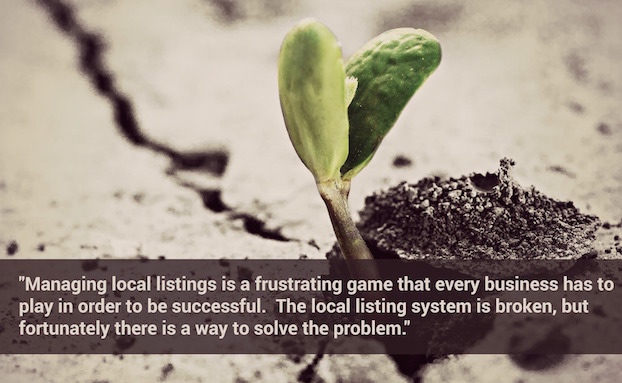Have you ever wondered why bad listings never die? Let me clarify. I am referring to the local listings for business locations that people find when searching online and via mobile devices. How about the ones with wrong information that keep popping up all over the Internet? Is this some crazy person’s version of marketing torture?
The good news is you do not have to continue playing the victim when it comes to your local listings. They can be cleaned up and you can go about your day obsessing over something else. For most people that something else is probably Facebook, but I digress.
Managing local listings is a frustrating game that every business has to play in order to be successful. The local listing system is broken, but fortunately there is a way to solve the problem. So here’s the skinny on local listings and why those ugly pimples (bad listings) show up all over the Internet’s pretty little face.
Where the Problem Started
Let’s go back to the beginning so we know where this all started. Most of the listings we see online came from a slow evolutionary process having its beginnings in the old phone book days. The early location databases were built through a couple of different processes. One company out there rips the spines off of phone books, scans each page, has an editor highlight columns, and then pulls the data into their database using Optical Character Recognition (OCR) software. Another company has the phone book records manually keyed utilizing offshore human resources.
Regardless of which system is utilized, it is not perfect. Even if it was, we would have to start with the assumption that the records were all correct in the phone book in the first place, and that is not the case. We know from years of experience that those books can become outdated soon after they are published.
Other Bad Listing Sources
Did your company ever have a membership in a local Chamber of Commerce? Was your company actually a member of multiple chambers? This can be good and this can be bad. It is good for the reasons you already know, but bad for reasons that pertain to local listings. Many chamber of commerce websites have not been updated for several years. I know this because I have seen plenty of them. Those websites were used as a carrot by several chambers to help gain your business some recognition in the local community, but the chambers are not good at maintaining those listings as your business navigates its way through changes. This is where problems occur.
When search engines find those old listings, they add them to their database assuming they are still relevant. After all, a reputable site like the chamber says that the location exists, so it must be correct. Therein lies the issue. The address of your business has changed, you may have even taken the step to update that listing on Google, and the next thing you know the old address pops up somehow and you cannot figure out where it came from. Check your old chamber memberships.
The same can be said for Better Business Bureau sites or any other site that maintains a record of business addresses. Once those addresses have gone stale and the website has missed the update, then those old addresses are picked up by search engine crawlers and the problem persists. It is unfortunate, but it happens.
Old websites are no different from old chamber and BBB websites. It is difficult for websites to be maintained. That can be good for you if you are trying to compete with those sites from an SEO perspective, but not so good if those websites contain incorrect location data about your company. These might be sites listing outdated partnerships, vendor relationships, press releases, or any other number of sites. You get the idea, and you probably see the issue.
The Diagnosis
Incorrect listings are one of those annoying things that keeps people up at night, creates uncomfortable phone calls from executives and angry clients, fills your inbox with emails from upset managers, and keeps Tylenol in business. However, this headache can be addressed. We just needed a face for the enemy.
The problem of bad listings exists for several reasons and we have explored the biggest of those: old phone books and outdated websites. Now that you have a clear picture of the root of the problem it is time to take the next step. Keep an eye out for my next article that will explain the process for getting all this cleaned up and resolved for good. As the diagnosis looks right now, it may appear a bit overwhelming, but I can assure you there is a cure.




